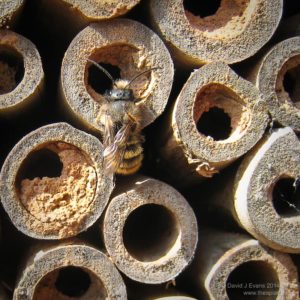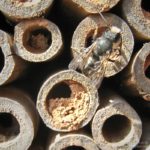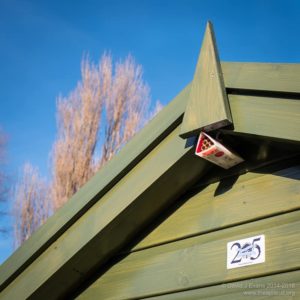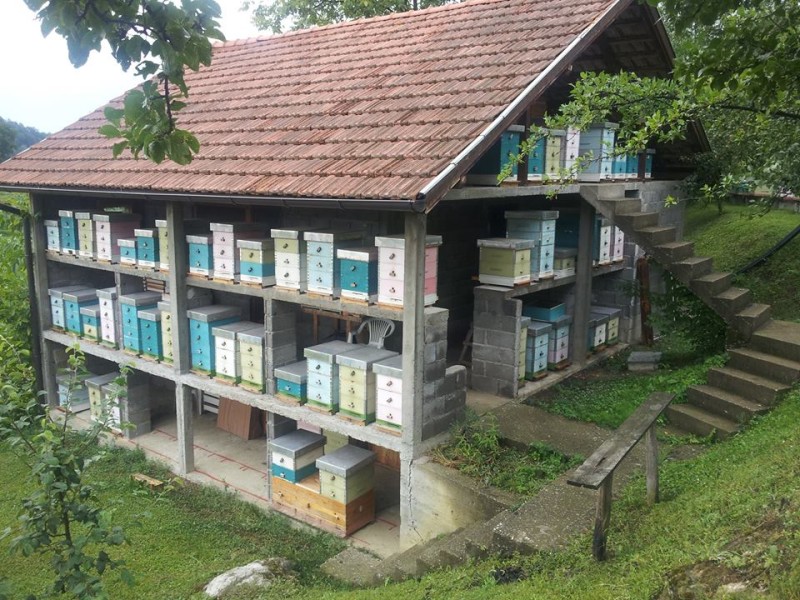The bee house
After the bee shed comes the bee house. However, in a break from tradition, this is a post about solitary bees rather than honey bees. Solitary bees include things like the Red Mason Bee. These were very common where I lived in the Midlands but this species of solitary bee is very much rarer in Scotland, although they are present in parts of Fife.

Steven Falk book
I’ve no idea what’s about in this area of Fife so I’m putting up a couple of solitary bee houses to see if I can attract any … and then I’ll try and identify them. To help with the latter I’ve recently been given a copy of the excellent Field Guide to the Bees of Great Britain and Ireland by Steven Falk. For beekeepers this book is a bit of a reality check … in ~430 pages densely packed with wonderful photographs, drawings and descriptions of bees of all shapes and sizes, Apis mellifera – the honey bee – gets just 2 pages. Pro rata, that’s perhaps a bit too much considering ‘our’ bee is just one of the 285 species in the UK and Ireland. To get an idea of the quality of the illustrations I suggest having a look at some of the outstanding photographs on Steven’s Flickr account … and don’t just restrict yourself to his bee photo collection.
There are lots of descriptions online about how to make houses for solitary bees. You can also buy them (often at silly prices) from garden centres and gift shops. However, they’re easy and much cheaper to make, and can be made to suit a much wider range of solitary bees with a little bit of effort, a few bits of untreated wood and a drill. Mine are even simpler than that … I just use a short length of plastic drainpipe stuffed with hollow bamboo canes. I make sure the drainpipe is a bit longer than the canes – to provide a sheltered entrance – and just stuff them in so tightly that the drainpipe distorts slightly. These aren’t particularly aesthetically pleasing, but they’ve worked well before. I’ve additionally got a few Grow Wild bee houses that come flat-packed in the Grow Wild flower seed kits. If you’re not familiar with these then make sure you register in 2017 and get some mixed wildflower seeds appropriate to your region. I’ve not used these bee houses before, they have a plastic outer with a hanging loop together with 10 cardboard tubes. These are perhaps a little too regular in diameter – you want some variation as not all solitary bees use the same sized holes. However, I’m sure it will still work. In comparison to some of the fancy commercial offerings these little plastic triangular prisms are more like bee tents than bee hotels.
The solitary bee house needs to be securely mounted off the ground, between about waist and head height, in a warm and sunny – but reasonably sheltered – position. Above the patio of our last house I zip-tied them to the drainpipes well above head height so they didn’t bother us when we were outside. Here I’ve put them on the back of the house and – perhaps appropriately – under the eaves of the bee shed.
Now all we need is the the weather to warm up and see what arrives …
And finally … you’ll note I make a distinction between my bee shed and both the solitary bee houses I discuss here and the extraordinary edifice below (a honey bee house). It all looks a bit precarious, both in terms of the construction and from a beekeeping point of view. The top row of hives must have to be inspected from the top of a ladder. It looks like the building is set into the slope behind and so there’s not a similar number of hives on the other two sides.
I can see a dirty great crack in the wall at the bottom of the image. Nevertheless, I bet sitting in that garden chair in the middle of the picture is a great experience when there’s a good nectar flow on and the air is thick with returning foragers.




Join the discussion ...